Near-surface and internal lamellar structure and orientation in thin films of rod–coil block copolymers†
Bradley D.
Olsen
ac,
Xuefa
Li
b,
Jin
Wang
b and
Rachel A.
Segalman
*ac
aDept. of Chemical Engineering, University of California, Berkeley, CA 94720, USA. E-mail: segalman@berkeley.edu
bAdvanced Photon Source, Argonne National Lab, Argonne, IL 60439
cMaterials Science Division, Lawrence Berkeley Laboratory, Berkeley, CA 94720, USA
First published on 9th February 2009
Abstract
Controlling the three-dimensional structure of rod–coil block copolymer thin films is critical for the optimization of the carrier transport properties and exciton dissociation or carrier recombination efficiencies at interfaces in optoelectronic polymers. Using a model rod–coil block copolymer based on poly(alkoxyphenylenevinylene-b-isoprene) (PPV-b-PI), the structure and orientation of thermally self-assembled rod–coil block copolymer thin films is investigated with grazing-incidence small-angle X-ray scattering (GISAXS), dynamic secondary ion mass spectrometry (DSIMS), scanning force microscopy (SFM), and cross-sectional transmission electron microscopy. Grains of lamellae are grown in films with one supported and one free interface by thermal annealing below the order–disorder transition from an initially structureless solution-cast state. In films only a few lamellar layers thick, parallel lamellar grains that span the entire film thickness are formed due to surface templating of lamellar orientation. As film thickness is increased, the lamellar block copolymers take on a bimodal orientation, with parallel and perpendicularly oriented microphases distributed uniformly throughout the center of the film. The vacuum interface is coated in a ∼10 nm thick layer of perpendicular lamellae, while the supported interface is covered with a single parallel oriented layer of block copolymer due to surface segregation of the polyisoprene block. Further increasing the thickness results in partial loss of orientational order as the bulk structure is approached. Strong suppression of the primary scattering peak is observed near a coil fraction of 0.7 for parallel lamellae, indicating changes in form factor from the bulk or perpendicularly oriented structures. Large dilations in the average perpendicular lamellar domain spacing are also observed in thin films as defects between perpendicular lamellar grains. As the film thickness increases, the lamellar period asymptotically decreases to the bulk value. The lamellae dilate rather than bending due to the high modulus of the PPV liquid crystalline nanodomains. Parallel lamellae show no dilation because of the free interface.
Introduction
Block copolymer thin films are an attractive tool for low cost nanopatterning and nanolithography due to the ability of block copolymers to self-assemble into a variety of thermodynamically stable phases on the 10 nm length scale.1–3 While much of the work to date has focused on using the block copolymer as a sacrificial layer, self-assembly of photovoltaic block copolymers4–7 or biologically functional polymers8,9 has the potential to directly produce functional nanopatterned soft materials. Many of these functional polymers have non-Gaussian morphologies due to their bonding or secondary structure, such as the rigid structure of semiconducting conjugated polymers or helical polymers and polypeptides. Patterning with these materials requires a detailed understanding of self-assembly in such non-ideal systems. Rod–coil block copolymers containing one of these rigid blocks and one flexible block are significantly different from coil–coil block copolymers due to anisotropic interactions between the rigid blocks and the difference in scaling behavior between the rod and coil blocks,10–12 resulting in a number of new and intriguing phases.13–19 As a result, the phase diagram of a model weakly-segregated rod–coil block copolymer is significantly different from the coil–coil block copolymer phase diagram, showing stable lamellar phases for most molecular weights and coil fractions16,20,21 with hexagonal phases observed at very high coil fractions and high coil to rod length ratios.16 Both nematic and isotropic disordered states are observed above the order–disorder transition due to aligning interactions between the liquid crystalline blocks.16,20,21Many applications of functional polymers also require self-assembly in thin films where geometric confinement normal to the interface and surface energy or surface segregation effects have a large impact on the nanostructure and orientation. Understanding equilibrium rod–coil block copolymer self-assembly in thin films has proven difficult because the morphology in these materials often reflects aggregate structures that were formed in solution and are kinetically trapped in the film during deposition.22–26 The final film morphology may also be influenced by the formation of lyotropic liquid crystalline phases during self-assembly, resulting in unusual zigzag morphologies,27 kinetically trapped arrangements of nanodomains,28 or defects that formed during transitions through the intermediate liquid crystalline phases. 9,29,30 The specific nature of the structures formed in these solution self-assembled films depends greatly on the specific details of the polymer chemistry, polymer–solvent interactions, and film casting method and rate. A small number of studies have also shown that microphase separation in thin films can be induced through thermal annealing,7,31–33 although frequently poor long range order is observed.5,34 Previous studies by our group have used the weakly-segregated system poly[2,5-di(2′-ethylhexyloxy)-1,4-phenylenevinylene-b-isoprene] (DEH-PPV-b-PI) to understand thermally-induced self-assembly into equilibrium lamellar structures with kinetically determined grain morphologies.32,33,35 Thin films of these materials contain lamellae primarily oriented parallel to the sample surface due to surface templating of lamellar order and selective segregation of the polyisoprene (PI) block to the Si interface.32 Perpendicular lamellae form defect structures between irregular polygons32 or square shaped grains33 of parallel lamellae. Increasing the film thickness results in a transition from predominantly parallel to completely perpendicular orientation at the vacuum interface. However, these previous studies have not probed beneath the vacuum interface. This raises important questions as to whether the supported interface continues to template parallel lamellar orientation away from the vacuum interface and how lamellar orientation and grain structure change throughout the thickness of the film. Controlling the three-dimensional structure is critical in controlling electronic transport and exciton dissociation or charge recombination in polymer electronics.
Understanding the three-dimensional structure in rod–coil block copolymer thin films poses a significant challenge. As evidenced by coil–coil block copolymers, the interface can have a profound effect on the structure, causing surface reconstructions that produce phases that are difficult to identify from information about the vacuum interface alone.36 A number of techniques, including cross-sectional transmission electron microscopy (TEM),37 electron tomography,14,38reflectivity,39dynamic secondary ion mass spectrometry (DSIMS),40,41 and alternate etching and imaging of films42 have proven useful in obtaining information on the three-dimensional structure of block copolymer thin films. More recently, grazing-incidence X-ray scattering (GISAXS) has developed as a valuable tool for investigating the structure of polymer films.43–48 By taking measurements around the critical angle of the polymer film, the total intensity of the scattered wave is enhanced, allowing a large signal to be obtained from the relatively small scattering volume of a thin film. Changes in X-ray incident angle change the X-ray penetration depth into the film, allowing the depth-dependent structure to be measured.49–51 However, GISAXS differs from traditional SAXS in that GISAXS is a semikinematic scattering technique where the incoming wave is distorted by the film, and the block copolymer structure is treated as a perturbation. These scattering equations have been solved using the distorted wave Born approximation (DWBA) by a number of authors.46,49,52,53GISAXS has proven invaluable for the characterization of block copolymer systems, including understanding the packing structure of sphere-forming block copolymers near surfaces as a function of film thickness43 and studying complex di- and triblock self-assembled film structures.46,47
In this work we study the three-dimensional structure of model PPV-b-PI rod–coil block copolymer films to understand the lamellar structure and orientation throughout the film. Using a combination of scattering (GISAXS), depth profiling (DSIMS), and imaging (scanning force microscopy, cross-sectional TEM), lamellar orientation distributions and structures are probed throughout the film depth. Transitions in lamellar orientation are investigated with increasing film thickness, and the changing impact of the surfaces on lamellar orientation is understood. The impact of confinement in thin films on the structure of both parallel and perpendicular lamellae is also determined, demonstrating changes in form factor for parallel lamellae and changes in domain spacing for perpendicularly oriented structures.
Experimental
Poly[2,5-di(2′-ethylhexyloxy)-1,4-phenylenevinylene-b-isoprene] (DEH-PPV-b-PI) block copolymers were synthesized and characterized to determine their microphase structure as described previously.20,21 All of the polymers formed lamellar phases in the bulk. The domain spacings, molecular weights, and coil fractions of all materials are summarized in Table 1. The number of volumetric repeat units, N, and the coil fraction, ϕ, are calculated based on a reference volume of one isoprene repeat unit. The ratio of the coil block radius of gyration to the rod block length, Rg/L, represents the degree of conformational asymmetry between the rod and coil and represents one of the four dimensionless variables characterizing rod–coil phase space. The polyisoprene block was synthesized anionically in benzene, yielding approximately 93% 1,4 addition as determined by 1H NMR. PPV-b-dPI-52 was synthesized in benzene from perdeuterated isoprene monomer (purchased from Polymer Source, 98% isotopic enrichment) to produce a deuterated polyisoprene block with approximately 65% 1,4 addition, as determined by 2H NMR. The polydispersity of the PPV blocks ranged between 1.15 and 1.17, and the polydispersities of all the PI blocks were less than 1.05.| Polymer | M n PPV/g mol−1 | M n PI/g mol−1 | ϕ | N | R g/L | Bulk domain spacing/nm |
|---|---|---|---|---|---|---|
| PPV-b-PI-41 | 5300 | 3400 | 0.41 | 120 | 0.196 | 15.0 |
| PPV-b-PI-42 | 3500 | 2400 | 0.42 | 82 | 0.245 | 13.9 |
| PPV-b-PI-59 | 3500 | 4700 | 0.59 | 116 | 0.345 | 17.0 |
| PPV-b-PI-67 | 3400 | 6300 | 0.67 | 138 | 0.417 | 21.4 |
| PPV-b-PI-72 | 3500 | 8100 | 0.72 | 166 | 0.454 | 24.6 |
| PPV-b-PI-73 | 5600 | 13![[thin space (1/6-em)]](https://www.rsc.org/images/entities/char_2009.gif) 700 700 |
0.73 | 277 | 0.371 | 35.1 |
| PPV-b-PI-82 | 3400 | 13![[thin space (1/6-em)]](https://www.rsc.org/images/entities/char_2009.gif) 900 900 |
0.82 | 249 | 0.620 | 30.0 |
| PPV-b-dPI-52 | 3500 | 3500 | 0.52 | 98 | 0.298 | 14.5 |
Samples were prepared for scanning force microscopy (SFM), grazing-incidence small-angle X-ray scattering (GISAXS), and dynamic secondary ion mass spectrometry (DSIMS) by spin-casting polymers from toluene solution. (100) Si substrates were purchased from University Wafer (Boston, MA). For DSIMS, the wafers were coated in a 300 nm layer of thermal oxide to insulate the film and allow stable charge compensation during the experiment. Spin coating solutions were prepared in toluene, and concentrations from 5 to 40 mg mL−1 and spin speeds between 900 and 6000 rpm were used to achieve film thicknesses of 7 to 350 nm. Sample thicknesses were measured using a Sentech SE400 ellipsometer with a 632.8 nm laser. Film thicknesses for both GISAXS and DSIMS were chosen to avoid the formation of islands or holes. Prior to annealing, the films were structureless. Samples of all polymers except PPV-b-PI-82 were annealed at 80 °C under vacuum for 24 h to induce structure formation; samples of PPV-b-PI-82 were annealed at room temperature (22–23 °C) for 24 h due to its low order–disorder transition and the propensity of this polymer to dewet the substrate at elevated temperatures. Although the polycrystalline grains of lamellae observed in all samples are not at a true thermodynamic equilibrium, longer annealing times did not result in noticeable structural evolution, indicating that the samples have achieved kinetically stable morphologies. SFM samples were analyzed on a Digital Instruments MultiMode AFM™ operating in tapping mode.
GISAXS experiments were performed at beamline 8-ID-E of the Advanced Photon Source using an experimental geometry similar to those described previously.46,52 Experiments were performed using a 0.1687 nm X-ray beam with a width of 100 µm and a height of 50 µm. Data was recorded on a 2D CCD detector, and the sample to detector distance was 2.27 m. Data was acquired for 30 s per frame, and three frames from different spots on the sample were added to generate the scattering plot. Scattering angles were converted into q-space accounting for the planarity of the detector. The qz axis is calculated using the direct beam as the reference beam and holding qxy fixed at zero. The qxy axis is similarly calculated holding qz fixed at zero. Although the geometry of the grazing-incidence experiment creates distortions in q-space, the qz and qxy axes approximately a Cartesian coordinate system to a high degree of accuracy in the small-angle regime. Scattering intensities are reported in arbitrary units, and the scales on two-dimensional scattering plots are linear.
Reflectivity curves were recorded for each GISAXS sample to allow determination of the critical angle. Critical angles were estimated for both the polymer and Si substrate from the experimental data, and an adjustment factor was calculated based on the offset between the experimental Si critical angle and the known value for the critical angle calculated as a function of X-ray wavelength using the freely available program XOP. The critical angles of the polymers were relatively insensitive to coil fraction; all films had a critical angle of 0.153°. Film thicknesses were also calculated from the reflectivity data and were consistent with the thickness measurements by ellipsometry.
DSIMS depth profiles were acquired using a Physical Electronics 6650 dynamic SIMS. A 2 kV, 30 nA beam of O2+ ions was rastered over the sample to etch a 200 µm × 200 µm crater. Charge neutralization was maintained with a 0.6 eV defocused electron beam. By using a block copolymer containing a hydrogenated PPV block and a deuterated PI block, the depth-dependent concentrations of PPV and PI are determined based on the relative abundance of deuterium and hydrogen ions through the depth of the film. Atomic abundances have been normalized by the carbon signal to correct for drift, and the etch rate has been converted to a quantitative depth scale using the known lamellar spacing of the block copolymer as measured by SAXS.
Samples for cross-sectional transmission electron microscopy (TEM) were prepared by spin-casting films from toluene directly onto an epoxy substrate. Films were then annealed at 80 °C for 24 h under vacuum and stained with OsO4 to increase mechanical toughness and provide contrast for imaging. The vacuum interfaces of the films were coated with thin layers of amorphous carbon and chrome before the films were embedded in epoxy and cryomicrotomed into 80 nm thick sections. Images were taken on a JEOL 200CX microscope operating at an accelerating voltage of 200 kV.
Results and discussion
Depth-dependent microdomain orientation
Lamellar structures in thin films of DEH-PPV-b-PI block copolymers order bimodally both parallel and perpendicular to the film surface. SFM phase images show this bimodal lamellar orientation at the vacuum interface (Fig. 1) and indicate that increasing the film thickness results in an increase in the fraction of perpendicular lamellae at the vacuum interface until this interface is completely covered by perpendicular structures. This reorientation transition is observed for all coil fractions. The combination of GISAXS, DSIMS depth profiling, and cross-sectional TEM can be used to probe the three-dimensional structure of the film, allowing the lamellar orientation and grain morphology to be fully understood. Although the lamellae near the vacuum surface reorient with increasing thickness, GISAXS demonstrates that the bimodal microdomain orientation both parallel and perpendicular to the interface is preserved even after complete reorientation of the vacuum interface, as shown in Fig. 2. The X-ray penetration depth into the polymer film is strongly dependent upon X-ray incident angle near the critical angle, allowing the upper ∼10 nm of the film to be sampled at angles just below the critical angle while to a first approximation the entire film is sampled at angles just above the critical angle, as shown in Fig. 2c.49 Differences in the GISAXS patterns above and below the critical angle indicate that even in films where the vacuum interface has a completely perpendicular orientation, both perpendicular and parallel lamellae are present. Below the critical angle only peaks along the horizontal axis are observed, indicating that all of the lamellae are oriented perpendicular to the surface within 10 nm of the vacuum interface. Above the critical angle, peaks are observed along both the horizontal and vertical axes, indicating the presence of both parallel and perpendicular lamellae deeper into the film.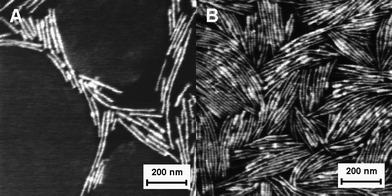 | ||
| Fig. 1 SFM phase images of lamellar structures in PPV-b-PI-42. PPV-rich nanodomains appear light, while PI-rich nanodomains appear dark due to differences in mechanical properties. Grains of perpendicularly oriented lamellae appear as alternating light and dark stripes, while parallel grains appear as featureless dark areas due to segregation of the PI block to the vacuum interface. Increasing film thickness results in an orientation transition from primarily parallel orientation (A, 45.5 nm thick) to primarily perpendicular orientation (B, 222.0 nm thick) at the vacuum interface. Variations in the width of the perpendicularly oriented lamellae are visible along their length; this lamellar dilation occurs to accommodate the strain induced by defects in the films. Phase scale is 30° for both images. | ||
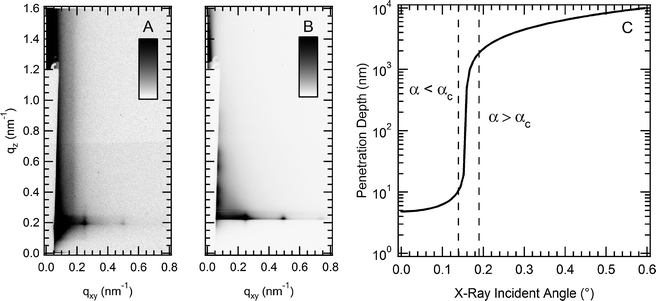 | ||
| Fig. 2 GISAXS patterns of PPV-b-PI-72 above and below the critical angle. Below the critical angle (A, 0.140°), the X-ray penetration depth into the film is only ∼10 nm. Scattering peaks are only observed in the horizontal direction, indicative of complete coverage of the vacuum interface with perpendicular lamellae for this 193.8 nm thick film. Above the critical angle (B, 0.190°) the X-rays penetrate the entire film, and scattering peaks are observed in both the horizontal and vertical directions. The penetration depth of the X-rays as a function of incident angle is shown in C. This indicates a bimodal distribution of parallel and perpendicular lamellae in the film even above the thickness at which the vacuum interface has transitioned to a purely perpendicular orientation. Scattering intensities are normalized to the primary peak intensity from the perpendicular lamellae and are plotted on a linear scale. | ||
A more detailed analysis of the GISAXS scattering intensities as a function of angle allows the distribution of these parallel lamellae throughout the film to be deduced, and it suggests that the parallel and perpendicular lamellae are approximately uniformly distributed throughout the depth of the film. Between the polymer film and substrate critical angles, interference between reflected and transmitted components of the dynamically scattered wave creates standing waves in the polymer film that allow the scattering intensity as a function of depth throughout the film to be varied.49–51 Small variations in the X-ray incident angle above the polymer film critical angle but below the substrate critical angle shift the location of these standing waves, allowing depth-dependent orientation information to be obtained. Variations in the total scattering intensity from a structure, calculated by integrating the scattered intensity of a peak corresponding to either parallel or perpendicular orientation, would be expected with the same frequency as the standing waves move through the film. From calculation of the standing waves in XOP, this frequency is approximately 0.01° for films of these thicknesses. The experimentally observed ratio of the total scattered intensity from parallel lamellae to the total scattered intensity from perpendicular lamellae varies only gradually over angular ranges of ∼0.1° above the critical angle, as shown in Fig. 3. These changes are too gradual and at too low a frequency to originate from nonuniform orientation as a function of depth. Since these intensity ratios must be interpreted through the distorted wave Born approximation (DWBA) in order to account for the distortion of the X-ray beams within the film, quantitative modeling would be necessary to determine the origin of the relatively gradual drift in intensity. This sort of intensive modeling is very challenging at this time, as only a few DWBA treatments of block copolymer GISAXS data have been attempted,5–7 and the full set of parameters necessary to characterize the structures including average grain size and orientational distribution for both parallel and perpendicular lamellae are difficult to extract from the experimental data. The only very gradual fluctuations in intensity ratio above the critical angle, however, are strong evidence for a uniform distribution of parallel and perpendicular lamellae.
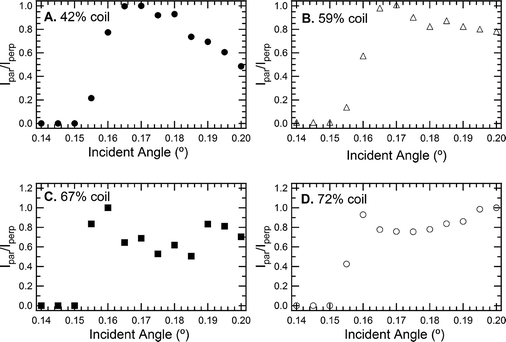 | ||
| Fig. 3 Ratio between scattering intensities from parallel and perpendicular lamellae as a function of GISAXS X-ray incident angle. For all coil fractions, scattering from parallel lamellae is not observed below the critical angle. Above the critical angle there are only gradual variations in the relative intensity, and few changes are observed with a period of approximately 0.01° corresponding to the period at which the peak electric field intensity cycles through the depth of the film with increasing incident angle. This indicates that there is little localization of the parallel or perpendicular orientations as a function of depth within the films. Film thicknesses are 264.8 nm for 42% coil, 236.7 nm for 59% coil, 246.1 nm for 67% coil, and 267.2 nm for 72% coil. | ||
Chemical depth profiling with DSIMS gives a real-space indication of the surface reconstruction, confirming the uniform distribution of lamellae throughout the center of the film and identifying the presence of a single parallel oriented layer at the Si interface that is undetectable with GISAXS. Using deuterium labeling of the PI block, DSIMS is able to measure the volume fractions of PI and PPV throughout the depth of the film, as shown for PPV-b-dPI-52 in Fig. 4. The volume fractions of rod and coil blocks near the vacuum interface of the film are both very close to their average concentrations, consistent with the presence of a coating of perpendicular lamellae at this interface with a thickness of approximately 10 nm. Below the thin surface layer, weak oscillations of the PPV and PI coil fractions are observed, indicative of the presence of parallel oriented lamellae. These oscillations rapidly decay with increasing depth into the film, and throughout the center of the film little variation is observed in either volume fraction. Since the GISAXS data indicates that both parallel and perpendicular lamellae are present in this region, the uniform concentration profiles demonstrate that there is little translational order between parallel grains. Near the lower surface of the film, continued high PI signal relative to the rapidly decreasing PPV signal indicates the presence of a surface segregated layer of the PI block due to its selective interaction with the Si surface. Although the PI volume fraction increases significantly, the measured PI signal only increases slightly due to the finite depth resolution of the DSIMS instrument which causes a broadening of the PI–SiO2 interface at the bottom of the film. The weak oscillations near the vacuum interface indicate that the presence of this interface templates the alignment of parallel lamellae, but this alignment does not persist for more than one or two lamellar layers into the film. In thinner films, this surface-induced templating persists throughout the depth of the film.32
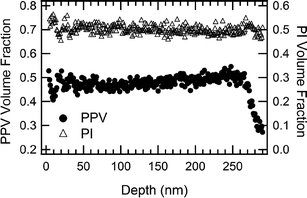 | ||
| Fig. 4 DSIMS depth profile for PPVb-d-PI-52. Near the surface, volume fractions for both PPV and PI are close to their average bulk values, consistent with the presence of a thin layer of perpendicular lamellae at the surface. Weak oscillations in volume fractions just below the upper interface indicate a slight alignment of parallel lamellae due to surface templating. The lack of variation in signal throughout the middle of the film indicates that the parallel and perpendicular grains are uniformly distributed. As the Si substrate is reached the PI coil fraction remains high, indicating selective segregation of the PI block to the interface. | ||
The amount of orientational disorder present in the bimodal orientation distribution depends strongly on the coil fraction and molecular weight of the block copolymers, and the competition between increasing segregation strength and decreasing mobility results in optimal orientation at an intermediate molecular weight and coil fraciton. Measurements of the peak width for lamellae oriented nearly perpendicular to the substrate are difficult due to the rapidly changing scattered intensity near the Yoneda fringe, making it difficult to quantify the orientational disorder for perpendicular structures. However, the angular widths of the scattering peaks from parallel lamellae can be quantitatively estimated since the reflection and transmission coefficients are not dependent on qxy (peak width direction) and vary only slowly with qz at higher scattering angles. For weakly-segregated PPV-b-PI materials (rod molecular weights ∼3500 g mol−1), increasing coil fraction results in a decrease in the peak angular full width at half maximum (FWHM) up to about 72% coil followed by a rapid increase as the coil volume fraction is further increased to 82%. Relatively symmetric block copolymers PPV-b-PI-42 and PPV-b-PI-59 have angular FWHM values of approximately 6° for films of 100–150 nm thickness, as shown in Fig. 5. Increasing the coil fraction to make the polymers moderately asymmetric results in a large decrease in angular FWHM; PPV-b-PI-67 and PPV-b-PI-72 have peak widths of approximately 1° for the same film thicknesses. Further increasing the coil fraction results in a rapid increase of the peak width to approximately 35° for PPV-b-PI-82. For this polymer, two-dimensional scattering patterns taken above the critical angle also clearly indicate the presence of a scattering ring at all film thicknesses, as illustrated in Fig. 6a. It is likely that an interplay between mobility and segregation strength results in optimum alignment at an intermediate coil fraction. While symmetric block copolymers show strong surface segregation and surface templating of alignment, the mobility of these polymers is hindered by the high PPV content, resulting in some angular disorder. As the coil fraction is increased the mobility increases, but the order to microphase disorder transition (ODT) temperature also decreases, resulting in weaker segregation and thus less interfacial segregation and templating. The interplay of these two effects creates the most oriented bimodal distribution for polymers with coil fractions of 0.67 and 0.72.
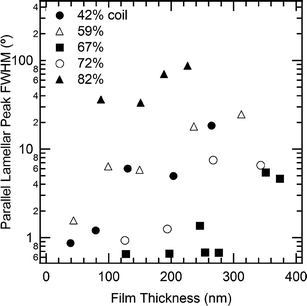 | ||
| Fig. 5 Experimental angular full widths at half maximum (FWHM) for q* peaks in parallel oriented lamellae. Increasing FWHM of the parallel lamellae at low coil fraction and larger film thickness indicates an increasing spread of the angular distribution around the ideal bimodal distribution. | ||
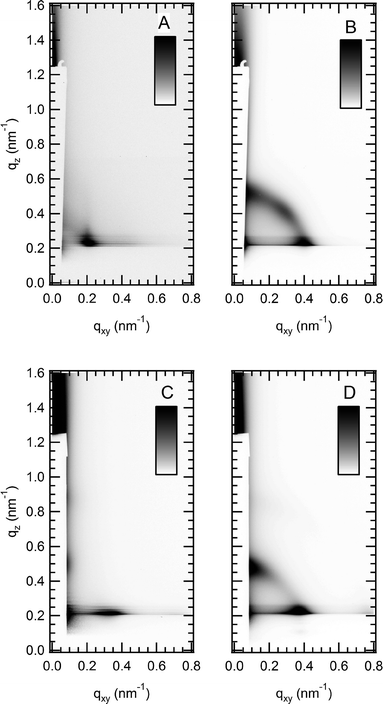 | ||
| Fig. 6 GISAXS scattering patterns of disordered bimodal orientations in DEH-PPV-b-PI thin films. (A) PPV-b-PI-82 shows a scattering ring and broad peaks for all film thicknesses, indicating that at coil fractions greater than 80% increased orientational order is observed even in thin films. The film thickness is 151.4 nm and the X-ray incident angle is 0.170°. (B) At higher molecular weight the polymer mobility is much lower, and the bimodal distribution breaks down. For PPV-b-PI-41, an intermediate peak is observed with a 45° tilt. The film thickness and incident angle are 357.7 nm and 0.185°, respectively. (C) Thin films of PPV-b-PI-59, as with all symmetric and moderately asymmetric weakly-segregated materials (rod molecular weight of approximately 3500 g mol−1), show bimodal orientations of parallel and perpendicular lamellae as indicated by relatively sharp scattering peaks in the horizontal and vertical directions. The film thickness is 99.6 nm and the pattern was acquired at an incident angle of 0.155°. (D) Increasing film thickness of PPV-b-PI-59 to 343.2 nm at the same X-ray incident angle results in the appearance of a scattering ring, indicating a large increase in the orientational disorder of the lamellar grains in thicker films. All incident angles are slightly above the critical angle for the X-ray wavelength used, and scattering intensities have been normalized to the primary peak intensity for perpendicularly oriented lamellae. The shade scales on all images are linear. | ||
The effect of kinetically trapped structures on the orientation distribution is also evidenced by films of moderately segregated polymers with higher molecular weight PPV rods. While films of ∼100 nm thick materials with a higher molecular weight rod still show a very sharp bimodal distribution with only parallel and perpendicular lamellae, in ∼300 nm thick films the increased rod length results in a large amount of orientational disorder, as shown in Fig. 6b. The distribution is no longer bimodal, with lamellae oriented parallel, perpendicular, and tilted 45° to the sample surface. The scattering peaks are broad and merge into an intense scattering ring, indicating that the orientational order is very poor. Increasing the coil fraction to 73% with a higher molecular weight rod (PPV-b-PI-73) results in an increase in orientational order at a given film thickness, consistent with the behavior observed in lower molecular weight materials.
Increasing the film thickness results in a slow transition from a bimodal orientation distribution to a randomly oriented polycrystalline bulk sample. Two-dimensional scattering plots, shown in Fig. 6c and d, illustrate the appearance of a ring at the largest thicknesses, indicative of a small fraction of lamellae with random orientation in the films. In addition, the FWHM of the scattering peak from the parallel lamellae increases with increasing thickness, indicating increased angular disorder in the parallel oriented structures, as shown in Fig. 5. This increase in orientational disorder is consistent with a transition to bulk behavior with increasing film thickness due to the decreasing effect of the interface throughout the film. However, it is notable that the GISAXS patterns below the critical angle always show only perpendicular lamellae, indicating that the angular disorder does not permeate the thin perpendicular layer near the vacuum surface.
Cross-sectional TEM of these films allows the lamellar grain structure to be directly visualized over comparatively small areas. Images of thick DEH-PPV-b-PI films, shown in Fig. 7, illustrate the polycrystalline structure with grains oriented both parallel and perpendicular to the substrate. Staining of these cross-sectional TEM images results in PPV-rich nanodomains that appear light and PI-rich nanodomains that appear dark. A significant amount of angular disorder in grain orientation is also observed, attributable to the combination of distortions in the relatively soft films during microtoming and imaging and the inherent angular disorder present in thicker films. Parallel lamellar structures are observed within 10–20 nm of the vacuum interface, indicating the very thin nature of the perpendicular lamellar coating.
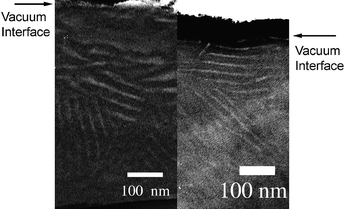 | ||
| Fig. 7 Cross-sectional TEM of PPV-b-PI-72. Cross-sectional TEM images show the disordered bimodal orientation throughout the film. Parallel lamellae are also observed in some locations near the vacuum interface, indicating that the perpendicular lamellar coating is relatively thin. Significant orientational disorder is observed due to the large film thickness of these samples (>500 nm). | ||
The combination of scattering, chemical depth profiling, and surface and cross-sectional imaging supports a structural model of these films as polycrystalline materials with bimodal parallel and perpendicular orientation throughout the center of the film, a parallel surface segregated layer at the supported interface, and a layer of perpendicular lamellae at the vacuum interface. This structure is schematically illustrated in Fig. 8. The films undergo two structural transitions with increasing thickness. In very thin films, predominantly parallel orientation is observed due to surface templating. Increasing thickness results in a gradual reorientation of the vacuum surface from parallel to perpendicular orientation accompanied by a transition of the bulk film to a polycrystalline bimodally oriented structure. We hypothesize that the perpendicular orientation at the vacuum interface indicates that the rod and coil blocks have roughly the same interfacial energy, so the lowest energy boundary is primarily a function of lamellar grain orientation or the liquid crystalline orientation of the rod blocks. As has been shown for lamellar block copolymer grains in bulk systems, the perpendicular lamellar orientation may have the lowest surface energy.54 Only a single PI layer that wets the Si substrate remains parallel templated in these intermediate thickness structures, and the number of lamellar layers at which this transition occurs decreases with increasing coil fraction.32,33 Further increasing thickness results in a loss of orientational order and a transition to the unoriented bulk polycrystalline structure.
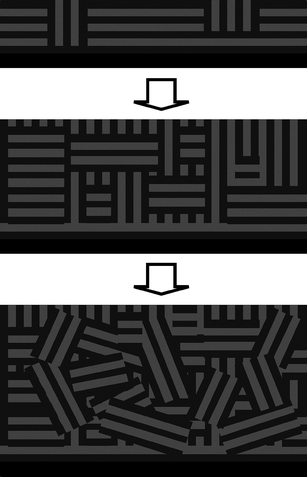 | ||
| Fig. 8 Lamellar structure in DEH-PPV-b-PI thin films with increasing film thickness. Thin films are dominated by parallel lamellar orientation due to selective segregation of the PI block to the interfaces and surface templating of lamellar order. As the film thickness is increased, the vacuum interface becomes coated in perpendicular lamellae and the film takes on a bimodal distribution of parallel and perpendicular lamellae uniformly distributed throughout the film. Only a single parallel PI layer remains due to segregation to the Si interface. As the film thickness is further increased, the orientational order in the film is lost and a polycrystalline bulk structure is approached. | ||
Changes in lamellar structure in thin films
Confinement in thin films has a large impact on the degree of long range order, the lamellar form factor, and the lamellar domain spacing of rod–coil block copolymers. Lamellae have better long range order in thin films than in bulk samples, as evidenced by the larger number of higher order peaks observed in both the horizontal and vertical directions. This enhanced order is due to templating of the block copolymer structure from the film interfaces, and it has been both theoretically predicted55 and experimentally observed40,56,57 in a large number of coil–coil block copolymer systems. Linecuts in both the horizontal (perpendicular lamellae) and vertical (parallel lamellae) directions are shown for all 5 block copolymers in Fig. 9. Scattering from the parallel lamellae above the critical angle produces a complex pattern of peaks along the qxy = 0 axis due to peak splitting and wavevector refraction that occurs in the DWBA approximation, so the peaks do not appear at integer multiples of the primary peak spacing.48,52 Higher order reflections up to 5q* and 6q* are observed in several of the lamellae oriented in the parallel direction, while only peaks up to 3q* are observed in these same materials in the bulk.20,21 It is also notable that the suppressed higher order peaks for each block copolymer (2q* for PPV-b-PI-42, 4q* for PPV-b-PI-67, and 5q* for PPV-b-PI-72) always occur at a coil fraction slightly less than that theoretically predicted, indicating that the coil nanodomain thickness is slightly larger than that predicted on the basis of coil fraction alone. This effect is consistent with slight rod solubility in the coil nanodomains in the weak segregation limit.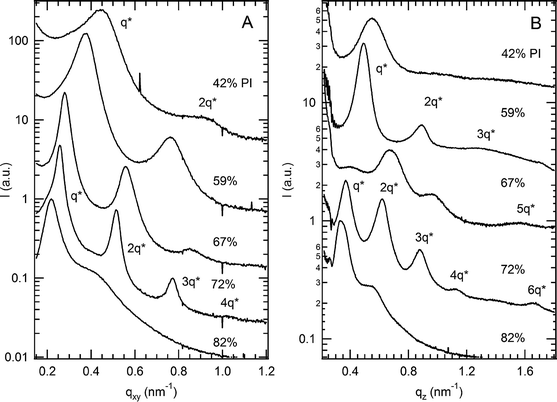 | ||
| Fig. 9 Linecuts of parallel and perpendicular lamellar structure in DEH-PPV-b-PI block copolymers. Lamellar structures in thin films are very well ordered, with peaks up to the 6q* peak observed in some materials. While perpendicular lamellae have similar scattering profiles to bulk samples, a significant suppression of the primary peak intensity is observed in block copolymers with 67% and 72% coil for parallel oriented lamellae. This suggests changes in the form factor of these parallel structures relative to bulk materials. Linecuts were taken from two-dimensional GISAXS images acquired at an X-ray incident angle of 0.155°, above the critical angle for the X-ray wavelength used. Linecuts for perpendicular lamellae (A) were taken at qz = 0.0202 Å−1 (the qz for specular reflection), and linecuts for parallel lamellae (B) were taken at qxy = 0.0085 Å−1. Film thicknesses are 264.8 nm for 42% coil, 236.7 nm for 59% coil, 246.1 nm for 67% coil, 267.2 nm for 72% coil, and 226.6 nm for 82% coil. | ||
Confinement into films also affects the form factor of the parallel lamellae, as evidenced by changes in the relative peak intensities between the parallel and perpendicularly oriented lamellae. In PPV-b-PI-67 and 72, suppression of the intensity of the primary scattering peak relative to the secondary peak is observed, resulting in a primary peak intensity that is lower than the secondary peak intensity. The peak suppression is much more pronounced for PPV-b-PI-67 than for PPV-b-PI-72, and it occurs for all film thicknesses and X-ray incident angles studied, indicating that these changes are not thickness dependent for relatively thin films and that the changes are not specific to lamellae localized near the interfaces. The well-known lamellar form factor is not consistent with this reduction of the primary peak intensity,58 making this effect quite surprising. This effect is not observed in bulk specimens of these materials, suggesting that the interface has an impact on the lamellar form factor. However, the origins of this effect remain unknown.
Significant changes in lamellar domain spacing are observed in rod–coil block copolymer films with changing film thickness. This dilation in lamellar spacing occurs as a way to accommodate defects in the lamellar structure. In lamellae with a perpendicular orientation, the domains are dramatically dilated in thin films as compared to the bulk, as shown in Fig. 10a. The domain spacing as a function of film thickness is fitted to an exponential decay, and the asymptotic limit at large thicknesses agrees very closely with the bulk domain spacing. Error bars on the graphs indicate the range of domain spacings observed for incident angles from 0.14 to 0.20°. There is little variability in domain spacing with changing X-ray incident angle, indicating that the extent of lamellar dilation does not depend on the depth of the lamellae within the film. The dilation of domain spacing observed by scattering in thin films is also easily seen in SFM images in Fig. 1 and the inset to Fig. 10a. The average domain spacing of perpendicular lamellae at the vacuum interface, measured by the Fourier transform of SFM images (see ESI†), confirms the asymptotic decay of domain spacing to the bulk value with increasing film thickness. The quantitative domain spacing measurements from GISAXS and SFM agree to within 7%.
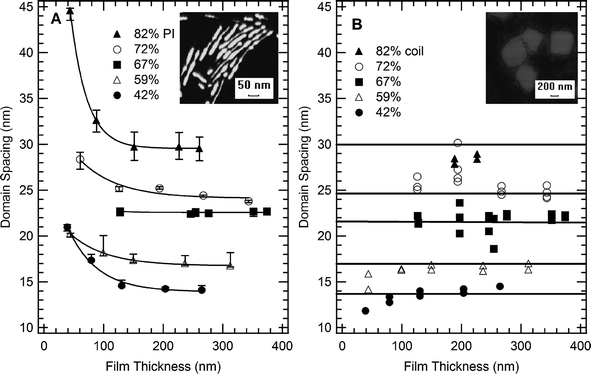 | ||
| Fig. 10 Domain spacing in rod–coil block copolymer films as a function of film thickness. Lamellae oriented perpendicular to the film surface show an exponential decay in domain spacing as the film thickness is decreased. At small film thicknesses, the lamellae are significantly dilated, consistent with SFM observations (inset: phase image, PPV-b-PI-59, 88.4 nm thick). As the film thickness is increased, the domain spacing approaches the bulk value. Error bars indicate the range of domain spacings measured as a function of X-ray incident angle. (B) For lamellae with a parallel orientation, the lamellar domain spacing is approximately constant as a function of film thickness for all coil fractions. Domain spacing was estimated just above the critical angle such that only a single peak was observable for each reflection, and the multiple data points at each sample thickness are estimated based on this analysis of all the higher order reflections. This is consistent with SFM observations of island and hole heights where the island height is equal to the bulk domain spacing (inset: height image PPV-b-PI-42, 22.2 nm thick). | ||
Due to the liquid crystalline order in the PPV rod nanodomains, the bending modulus of the lamellae is much higher than the microdomain compressibility.32 Therefore, it is more favorable for lamellae to dilate than to bend to accommodate the stresses around defects in the films. The fact that the average lamellar period is most strongly dilated in the thinnest films implies that the stress on defect lamellae is strongest in these films where there is little room for defect accommodation. As film thickness is increased defects may be accommodated more gradually or delocalized over a larger volume, resulting in lower stress on the lamellae and a gradual decay of the lamellar period to an undilated (bulk) state.
The magnitude of these changes shows a strong dependence on coil fraction, with large changes observed at both very high and very low coil fractions, and relatively small changes observed around 70% coil, due to the interplay between mobility and the modulus of lamellar dilation. The extent of lamellar dilation decreases with increasing coil fraction from 42% coil to approximately 70% coil, consistent with increasing mobility in these polymers with increasing coil fraction. In the case of PPV-b-PI-67, a change in domain spacing cannot be observed at small film thicknesses because scattering from perpendicular lamellae is not observed in films less than 100 nm thick, consistent with the SFM observation of only a few perpendicularly oriented defects in these films. A further increase in coil fraction to 82% results in a large increase in dilation of the domain spacing. The increased disorder present in these systems as the ODT temperature decreases may result in a decrease in the lamellar dilational modulus, allowing relatively small stresses to produce a large dilation. Therefore, the balance between increasing mobility and increasing disorder and flexibility result in minimum dilation at intermediate coil fractions. The rate at which the lamellar dilation decays back to the bulk value may be estimated from the characteristic decay length of the empirical exponential fit. The decay length is approximately constant up to a coil fraction of 0.72, then decreases significantly at a coil fraction of 0.82. The decay of the lamellar dilation with increasing film thickness is relatively slow for most coil fractions, with a characteristic decay thickness of 50–70 nm. However, at 82% coil, the decay length rapidly decreases to 20 nm. At the highest coil fractions it is likely that the increased mobility and flexibility of the polymers leads to better relaxation of the dilation and defect structures, resulting in bulk domain spacings being observed in thinner films.
In contrast to the large changes observed in perpendicular lamellae, parallel lamellae show similar domain spacing at all film thicknesses, as shown in Fig. 10b. Estimates of the domain spacing were performed based on the positions of each of the higher order peaks just above the critical angle so that peak splitting effects are minimized. Domain sizes were calculated accounting for reflection effects in the DWBA. Within the error in these estimates, the domain spacing is consistent with the bulk value. The scattering data is in agreement with measurements of domain spacing based on island or hole heights, as shown in the inset to Fig. 10b. Parallel lamellae are not dilated like perpendicular lamellae because they are confined between one rigid and one free interface; therefore, they are not subjected to any compressive stress.
Conclusions
The structure and orientation of weakly-segregated rod–coil block copolymers was studied using a model system based on DEH-PPV-b-PI block copolymers. Grains of lamellae were grown by thermal annealing in films with one supported and one free interface. Increasing film thickness results in a series of transitions through different lamellar orientations within the film. In the thinnest films, surface templating of parallel lamellar order results in films with primarily parallel oriented nanodomains that form well-ordered single grains that span the entire film thickness. Increasing thickness results in a transition of the film to polycrystalline bimodal parallel and perpendicular orientation accompanied by a transition at the vacuum interface to entirely perpendicular orientation. The lamellar orientations are uniformly distributed throughout the film, and only a single parallel oriented layer of block copolymer remains at the buried Si interface. Increasing thickness further results in disordering of the bimodal orientation as bulk polycrystalline self-assembly is approached. The lamellar structures in both the parallel and perpendicular orientations are distorted in the films. Parallel oriented lamellae show large changes in the relative intensity of the primary peak around a coil volume fraction of 0.7, indicating changes in the form factor of the lamellae relative to the perpendicular oriented or bulk structures. Perpendicular oriented lamellae show significant dilation of their domain spacing in thin films in order to accommodate defects between the parallel oriented grains. The extent of dilation decays exponentially to the bulk domain spacing with increasing film thickness. Parallel lamellae show no dilation.Acknowledgements
We gratefully acknowledge support from an NSF CAREER award. This work made use of the Materials Research Lab Central Facilities at the University of California Santa Barbara supported by the National Science Foundation. We would like to thank Tom Mates for assistance with SIMS experiments. GISAXS experiments were conducted at the APS, supported by the U. S. Department of Energy, Office of Basic Energy Sciences, under Contract No. W-31-109-ENG-38. The authors thank the APS Sector 8 staff for assistance with these experiments. TEM experiments were performed at the National Center for Electron Microscopy at LBNL, also supported by the U. S. Department of Energy, Office of Basic Energy Sciences. B.D. Olsen gratefully acknowledges the Fannie and John Hertz Foundation for a graduate fellowship.References
- F. S. Bates and G. H. Fredrickson, Phys. Today, 1999, 52, 32 CrossRef CAS.
- R. A. Segalman, Mater. Sci. Eng., R, 2005, 48, 191.
- C. Harrison, J. A. Dagata and D. H. Adamson, in Developments in Block Copolymer Science and Technology, ed. I. W. Hamley, John Wiley & Sons Ltd., New York 2004, pp. 295 Search PubMed.
- X. Yang and J. Loos, Macromolecules, 2007, 40, 1353 CrossRef CAS.
- B. de Boer, U. Stalmach, P. F. van Hutten, C. Melzer, V. V. Krasnikov and G. Hadziioannou, Polymer, 2001, 42, 9097 CrossRef CAS.
- S. Lu, T. X. Liu, L. Ke, D. G. Ma, S. J. Chua and W. Huang, Macromolecules, 2005, 38, 8494 CrossRef CAS.
- B. W. Boudouris, C. D. Frisbie and M. A. Hillmyer, Macromolecules, 2008, 41, 67 CrossRef CAS.
- K. Kirshenbaum, A. E. Barron, R. A. Goldsmith, P. Armand, E. K. Bradley, K. T. V. Truong, K. A. Dill, F. E. Cohen and R. N. Zuckermann, Proc. Natl. Acad. Sci. U. S. A., 1998, 95, 4303 CrossRef CAS.
- E. A. Minich, A. P. Nowak, T. J. Deming and D. J. Pochan, Polymer, 2004, 45, 1951 CrossRef CAS.
- R. Holyst and M. Schick, J. Chem. Phys., 1992, 96, 730 CrossRef CAS.
- V. Pryamitsyn and V. Ganesan, J. Chem. Phys., 2004, 120, 5824 CrossRef CAS.
- M. W. Matsen and C. Barrett, J. Chem. Phys., 1998, 109, 4108 CrossRef CAS.
- J. T. Chen, E. L. Thomas, C. K. Ober and G. P. Mao, Science, 1996, 273, 343 CrossRef CAS.
- L. H. Radzilowski, B. O. Carragher and S. I. Stupp, Macromolecules, 1997, 30, 2110 CrossRef CAS.
- K. K. Tenneti, X. F. Chen, C. Y. Li, Y. F. Tu, X. H. Wan, Q. F. Zhou, I. Sics and B. S. Hsiao, J. Am. Chem. Soc., 2005, 127, 15481 CrossRef CAS.
- B. D. Olsen and R. A. Segalman, Macromolecules, 2007, 40, 6922 CrossRef CAS.
- N. Sary, C. Brochon, G. Hadziioannou and R. Mezzenga, Eur. Phys. J. E, 2007, 24, 379 CrossRef CAS.
- N. Sary, R. Mezzenga, C. Brochon, G. Hadziioannou and J. Ruokolainen, Macromolecules, 2007, 40, 3277 CrossRef CAS.
- N. Sary, L. Rubatat, C. Brochon, G. Hadziioannou, J. Ruokolainen and R. Mezzenga, Macromolecules, 2007, 40, 6990 CrossRef CAS.
- B. D. Olsen and R. A. Segalman, Macromolecules, 2005, 38, 10127 CrossRef CAS.
- B. D. Olsen and R. A. Segalman, Macromolecules, 2006, 39, 7078 CrossRef CAS.
- P. Leclere, A. Calderone, D. Marsitzky, V. Francke, Y. Geerts, K. Mullen, J. L. Bredas and R. Lazzaroni, Adv. Mater., 2000, 12, 1042 CrossRef CAS.
- H. B. Wang, H. H. Wang, V. S. Urban, K. C. Littrell, P. Thiyagarajan and L. P. Yu, J. Am. Chem. Soc., 2000, 122, 6855 CrossRef CAS.
- P. Leclere, E. Hennebicq, A. Calderone, P. Brocorens, A. C. Grimsdale, K. Mullen, J. L. Bredas and R. Lazzaroni, Prog. Polym. Sci., 2003, 28, 55 CrossRef CAS.
- M. A. Hempenius, B. M. W. Langeveld-Voss, J. van Haare, R. A. J. Janssen, S. S. Sheiko, J. P. Spatz, M. Moller and E. W. Meijer, J. Am. Chem. Soc., 1998, 120, 2798 CrossRef CAS.
- S. I. Stupp, V. LeBonheur, K. Walker, L. S. Li, K. E. Huggins, M. Keser and A. Amstutz, Science, 1997, 276, 384 CrossRef.
- J. T. Chen and E. L. Thomas, J. Mater. Sci., 1996, 31, 2531 CrossRef CAS.
- J. S. Liu, E. Sheina, T. Kowalewski and R. D. McCullough, Angew. Chem., Int. Ed., 2001, 41, 329.
- J. W. Park and E. L. Thomas, Adv. Mater., 2003, 15, 585 CrossRef CAS.
- J. W. Park and E. L. Thomas, Macromolecules, 2006, 39, 4650 CrossRef CAS.
- T. Heiser, G. Adamopoulos, M. Brinkmann, U. Giovanella, S. Ould-Saad, C. Brochon, K. van de Wetering and G. Hadziioannou, Thin Solid Films, 2006, 511, 219 CrossRef.
- B. D. Olsen, X. Li, J. Wang and R. A. Segalman, Macromolecules, 2007, 40, 3287 CrossRef CAS.
- B. D. Olsen, M. F. Toney and R. A. Segalman, Langmuir, 2008, 24, 1604 CrossRef CAS.
- P. Leclere, V. Parente, J. L. Bredas, B. Francois and R. Lazzaroni, Chem. Mater., 1998, 10, 4010 CrossRef CAS.
- B. D. Olsen, D. Alcazar, V. Krikorian, M. F. Toney, E. L. Thomas and R. A. Segalman, Macromolecules, 2008, 41, 58 CrossRef CAS.
- R. Magerle, Phys. Rev. Lett., 2000, 85, 2749 CrossRef CAS.
- T. Xu, C. J. Hawker and T. P. Russell, Macromolecules, 2005, 38, 2802 CrossRef CAS.
- H. Sugimori, T. Nishi and H. Jinnai, Macromolecules, 2005, 38, 10226 CrossRef CAS.
- A. Gibaud and S. Hazra, Curr. Sci., 2000, 78, 1467 CAS.
- H. Yokoyama, T. E. Mates and E. J. Kramer, Macromolecules, 2000, 33, 1888 CrossRef CAS.
- H. Yokoyama, E. J. Kramer, M. H. Rafailovich, J. Sokolov and S. A. Schwarz, Macromolecules, 1998, 31, 8826 CrossRef CAS.
- M. Konrad, A. Knoll, G. Krausch and R. Magerle, Macromolecules, 2000, 33, 5518 CrossRef CAS.
- G. E. Stein, E. J. Kramer, X. F. Li and J. Wang, Macromolecules, 2007, 40, 2453 CrossRef CAS.
- G. E. Stein, E. J. Kramer, X. Li and J. Wang, Phys. Rev. Lett., 2007, 98, 158302 CrossRef CAS.
- V. Khanna, E. W. Cochran, A. Hexemer, G. E. Stein, G. H. Fredrickson, E. J. Kramer, X. Li, J. Wang and S. F. Hahn, Macromolecules, 2006, 39, 9346 CrossRef CAS.
- B. Lee, I. Park, J. Yoon, S. Park, J. Kim, K. W. Kim, T. Chang and M. Ree, Macromolecules, 2005, 38, 4311 CrossRef CAS.
- P. Busch, D. Posselt, D. M. Smilgies, M. Rauscher and C. M. Papadakis, Macromolecules, 2007, 40, 630 CrossRef CAS.
- P. Busch, M. Rauscher, D. M. Smilgies, D. Posselt and C. M. Papadakis, J. Appl. Crystallogr., 2006, 39, 433 CrossRef CAS.
- U. Pietsch, V. Holy and T. Baumbach, High-Resolution X-Ray Scattering: From Thin Films to Lateral Nanostructures, Springer, New York, 2004 Search PubMed.
- J. Wang, M. J. Bedzyk, T. L. Penner and M. Caffrey, Nature, 1991, 354, 377 CrossRef CAS.
- S. Narayanan, D. R. Lee, R. S. Guico, S. K. Sinha and J. Wang, Phys. Rev. Lett., 2005, 94.
- M. P. Tate, V. N. Urade, J. D. Kowalski, T. C. Wei, B. D. Hamilton, B. W. Eggiman and H. W. Hillhouse, J. Phys. Chem. B, 2006, 110, 9882 CrossRef CAS.
- S. K. Sinha, E. B. Sirota, S. Garoff and H. B. Stanley, Phys. Rev. B, 1988, 38, 2297 CrossRef.
- N. P. Balsara, C. M. Marques, B. A. Garetz, M. C. Newstein and S. P. Gido, Phys. Rev. E, 2002, 66, 052802 CrossRef CAS.
- G. H. Fredrickson, Macromolecules, 1987, 20, 2535 CrossRef CAS.
- M. J. Fasolka and A. M. Mayes, Annu. Rev. Mater. Res., 2001, 31, 323 CrossRef CAS.
- G. Krausch and R. Magerle, Adv. Mater., 2002, 14, 1579 CrossRef CAS.
- R.-J. Roe, Methods of X-Ray and Neutron Scattering in Polymer Science, Oxford University Press, New York, 2000 Search PubMed.
Footnote |
| † Electronic supplementary information (ESI) available: Domain spacing of PPV-b-PI-42 perpendicular lamellae determined by SFM; exponential decay parameter with changing coil fraction. See DOI: 10.1039/b809092k |
| This journal is © The Royal Society of Chemistry 2009 |
